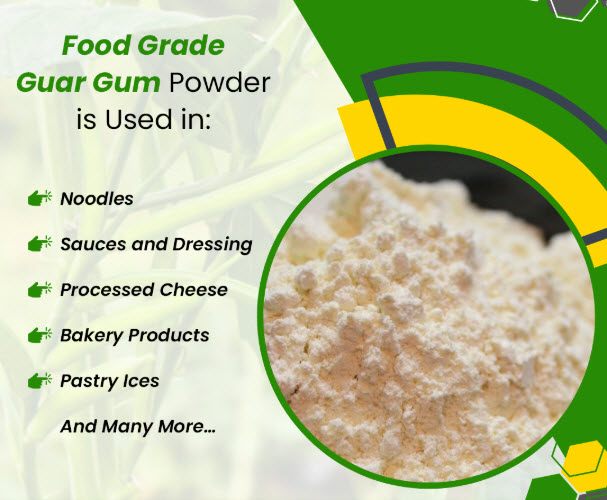Moisture retention is one of the most crucial challenges in frozen food preservation. It affects texture, flavor and shelf life. Ice crystal formation, freezer burn and drying during thawing can damage food quality. This naturally derived additive works silently but effectively to bind water, reduce syneresis and stabilize frozen products.
In this article, we will explore how guar gum for food applications-especially in frozen food manufacturing-deliver consistent results, improved mouthfeel and commercial reliability.
Food Grade Guar Gum Powder in Water-Binding Mechanisms

Freezing alters the structure of food. Water expands, ice crystals form and upon thawing, liquid separates from the food mass. Food grade guar gum powder manages this by binding free water within the matrix of the product.
Key Functional Roles:
- Holds water tightly without forming visible gels.
- Slows down ice crystal growth during freezing.
- Reduces separation during thawing.
This is particularly helpful in frozen baked goods, doughs and prepared meals where moisture uniformity is essential.
Guar Gum Powder Food Grade in Texture Preservation
Frozen foods must maintain their original texture after defrosting. Without stabilizers, meat, vegetables and sauces can turn grainy or rubbery. Guar gum powder food grade helps maintain structural integrity during both freezing and heating.
Texture-Related Effects:
- Improves chewiness in frozen meat patties.
- Maintains elasticity in doughs.
- Prevents brittleness in gluten-free items.
Even after extended freezer storage, products formulated with guar gum reheat evenly and feel fresh on the palate.
Gummy Guar and Its Role in Moisture Lock-in for Dairy and Desserts
Dairy-based frozen products like ice cream, yogurt pops and mousse benefit immensely from gummy guar. It prevents icy texture and ensures smoothness by controlling water movement and air incorporation.
Impact on Frozen Dairy:
- Reduces syneresis during storage.
- Inhibits air bubble expansion.
- Keeps fat, water and solids suspended uniformly.
Gummy guar’s elastic properties allow it to accommodate temperature fluctuations during transport without product degradation.
Guar Gum for Food Used in Ready-to-Eat Frozen Meals
Microwavable frozen meals are complex systems with proteins, sauces, starches and vegetables. Guar gum for food stabilizes moisture across all components during both freezing and reheating.
Functional Use Cases:
- Prevents sauce separation in gravies and curries.
- Maintains softness of rice, noodles or mashed potatoes.
- Reduces freezer burn effect on proteins and veggies.
This allows food manufacturers to deliver uniform quality across regions and shelf durations.
Food-Grade Guar Gum Packing and Storage for Maximum Purity
Quality starts at production but ends with packaging. The hygienic and safe packaging of food-grade guar gumensures the material doesn’t pick up moisture or contaminants before use.
Packing Protocols:
- Filled in sealed, food-safe HDPE or multi-wall paper bags.
- Sized for bulk but flexible enough for various markets.
- Stored in moisture-resistant environments to prevent clumping.
These conditions help preserve the polymer’s performance in all formulations, especially those sensitive to humidity shifts.
Guar Meal and Its Non-Relevance in Frozen Food Applications
It’s important to distinguish guar meal-a byproduct of gum extraction-from the gum itself. While meal has value in animal nutrition, it has no role in frozen food production.
Why It Doesn’t Apply?
- High in protein but lacks water-binding functionality.
- May introduce off-flavors or spoilage risk.
- Can disrupt mouthfeel in fine-textured products.
When buying guar products for food, make sure it is clearly labeled food grade guar gum powder and not meal or industrial blend.
How Guar Gum Enhances Freezer-to-Table Consistency?
Consumers expect their frozen foods to taste freshly made. Guar gum powder food grade supports this expectation by working silently through every stage-formulation, freezing, thawing and reheating.
Consistency Gains:
- Predictable hydration and dispersion.
- Stable viscosity under freezing temperatures.
- No grittiness or lump formation post-thaw.
In commercial kitchens and home use alike, these characteristics improve confidence in product quality.
Conclusion
Frozen foods demand ingredients that work behind the scenes-quietly enhancing texture, holding moisture and keeping structure intact. Food grade guar gum, including its variants like guar gum powder food grade and gummy guar, performs all these roles with remarkable efficiency. Whether it's for desserts, meals, baked items or sauces, its ability to control water makes it an indispensable part of frozen food formulation.
Manufacturers benefit not only from better product performance but also from fewer customer complaints, improved shelf life and better reheating results. When paired with clean, flexible packaging and proper storage, the full power of guar gum for food can be realized-batch after batch.
FAQs
Related Articles
1. Use Of Guar Gum Powder In Oil & Food Grade Items
2. Understanding Food Grade Guar Gum Powder: Uses, Benefits, and FAQs
3. Food Grade Guar Gum Powder and Its Important Applications
Web Design & Digital Marketing by Opal Infotech


